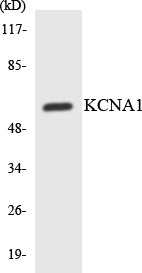| Post Translational Modifications | N-glycosylated. Palmitoylated on Cys-243.which may be required for membrane targeting. Phosphorylated on tyrosine residues. Phosphorylation increases in response to NRG1.this inhibits channel activity. Phosphorylation at Ser-446 regulates channel activity by down-regulating expression at the cell membrane. |
| Function | Voltage-gated potassium channel that mediates transmembrane potassium transport in excitable membranes, primarily in the brain and the central nervous system, but also in the kidney. Contributes to the regulation of the membrane potential and nerve signaling, and prevents neuronal hyperexcitability. Forms tetrameric potassium-selective channels through which potassium ions pass in accordance with their electrochemical gradient. The channel alternates between opened and closed conformations in response to the voltage difference across the membrane. Can form functional homotetrameric channels and heterotetrameric channels that contain variable proportions of KCNA1, KCNA2, KCNA4, KCNA5, KCNA6, KCNA7, and possibly other family members as well.channel properties depend on the type of alpha subunits that are part of the channel. Channel properties are modulated by cytoplasmic beta subunits that regulate the subcellular location of the alpha subunits and promote rapid inactivation of delayed rectifier potassium channels. In vivo, membranes probably contain a mixture of heteromeric potassium channel complexes, making it difficult to assign currents observed in intact tissues to any particular potassium channel family member. Homotetrameric KCNA1 forms a delayed-rectifier potassium channel that opens in response to membrane depolarization, followed by slow spontaneous channel closure. In contrast, a heterotetrameric channel formed by KCNA1 and KCNA4 shows rapid inactivation. Regulates neuronal excitability in hippocampus, especially in mossy fibers and medial perforant path axons, preventing neuronal hyperexcitability. Response to toxins that are selective for KCNA1, respectively for KCNA2, suggests that heteromeric potassium channels composed of both KCNA1 and KCNA2 play a role in pacemaking and regulate the output of deep cerebellar nuclear neurons. May function as down-stream effector for G protein-coupled receptors and inhibit GABAergic inputs to basolateral amygdala neurons. May contribute to the regulation of neurotransmitter release, such as gamma-aminobutyric acid (GABA) release. Plays a role in regulating the generation of action potentials and preventing hyperexcitability in myelinated axons of the vagus nerve, and thereby contributes to the regulation of heart contraction. Required for normal neuromuscular responses. Regulates the frequency of neuronal action potential firing in response to mechanical stimuli, and plays a role in the perception of pain caused by mechanical stimuli, but does not play a role in the perception of pain due to heat stimuli. Required for normal responses to auditory stimuli and precise location of sound sources, but not for sound perception. The use of toxins that block specific channels suggest that it contributes to the regulation of the axonal release of the neurotransmitter dopamine. Required for normal postnatal brain development and normal proliferation of neuronal precursor cells in the brain. Plays a role in the reabsorption of Mg(2+) in the distal convoluted tubules in the kidney and in magnesium ion homeostasis, probably via its effect on the membrane potential. |
| Protein Name | Potassium Voltage-Gated Channel Subfamily A Member 1Voltage-Gated K(+ Channel HukiVoltage-Gated Potassium Channel Hbk1Voltage-Gated Potassium Channel Subunit Kv1.1 |
| Database Links | Reactome: R-HSA-1296072 |
| Cellular Localisation | Cell MembraneMulti-Pass Membrane ProteinMembraneCell ProjectionAxonCytoplasmic VesiclePerikaryonEndoplasmic ReticulumDendriteCell JunctionSynapsePresynaptic Cell MembranePresynapseHomotetrameric Kcna1 Is Primarily Located In The Endoplasmic ReticulumInteraction With Kcna2 And Kcnab2 Or With Kcna4 And Kcnab2 Promotes Expression At The Cell Membrane |
| Alternative Antibody Names | Anti-Potassium Voltage-Gated Channel Subfamily A Member 1 antibodyAnti-Voltage-Gated K(+ Channel Huki antibodyAnti-Voltage-Gated Potassium Channel Hbk1 antibodyAnti-Voltage-Gated Potassium Channel Subunit Kv1.1 antibodyAnti-KCNA1 antibody |
Information sourced from Uniprot.org












